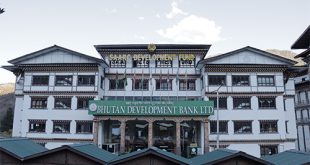One of the interesting aims of the 21st Century Economic Roadmap under Digital Economy is to build Data Centers to meet the global rush to expand data center capacity to support the proliferation of Artificial Intelligence (AI), cloud computing and data storage.
As per the 21st Century Economic Roadmap implementation plan, the aim is to build a 40-50 MW data center which will require an investment of around USD 450 million (mn) with construction starting in 2027 and lasting three years.
The AI data center’s GDP contribution will peak during construction, but decline afterward, shifting to indirect impacts such as electricity purchases and local employment.
The aim in the short-term is for the GovTech Agency and DHI to complete a detailed feasibility study for establishing data centers in Bhutan covering data center market, including trends and potential demand, baseline of an energy allocation framework, identification of potential sites, key infrastructure and facilities, and talent required and frameworks for partnership, investment and commercial agreement, operational approach, governance structures and FDI requirements.
In the short to medium term, GovTech will engage with potential data center partners (Data centre providers, AI players, solution providers and corporates) who could establish data centers.
An official said that the USD 450 mn cost to build the data center would only be the basic cost of the site and the machines, but the main and real cost would come in terms of the NVIDIA chips, and if that is included then a total cost would be around USD 40 to 50 mn per MW which is USD 4 to 5 billion (bn) for a 100 MW data center or USD 2 to 2.5 bn for a 50 MW data center.
The official said the project can happen either in the Gelephu Mindfulness City (GMC) or in the rest of Bhutan depending on the fiscal and legal benefits as Bhutan already has the advantage of clean energy.
The official said that Bhutan cannot make an investment of this scale by itself, and so it has to find credible strategic partners first to raise money, and make international approaches. Then the project would have to find hyperscalers clients like Amazon, Microsoft Corp., Alphabet etc., or leading data center providers who would sign on to rent or lease space and store data.
This sign on can be used to raise more funds. One of the strategies could also be in approaching NVIDIA for financing options. There are other strategies also being looked at.
The official said that a lot of technology and such businesses are moving or happening in the east, and this is a good thing for India.
AI and the large and small language models are also developing. One of the potential partners or customers could be firms in India.
The Roadmap says that the surge in energy demand from data centers is outpacing the available power supply in many parts of the world. Currently, there are more than 11,000 data centers built or in various stages of development, which require upwards of 508 TWh of electricity per year. By 2034, global energy consumption by data centers is expected to top 1,580 TWh, almost equivalent to India’s consumption.
The global demand for data center capacity could rise at an annual rate of 19-22 percent from 2023 to 2030, reaching 171 to 219 GW.
With an installed capacity for hydroelectricity generation of approximately 2,326 MW (2023) and plans to increase commissioning of more hydroelectricity capacity, Bhutan is well positioned to take advantage of the data center boom. Bhutan’s abundant renewable hydro energy aligns with the goals of leading data centre providers including hyperscalers such as Amazon, Microsoft Corp., and Alphabet to run their data centers entirely on green energy.
Big Tech companies such as Amazon, Meta, Microsoft, and Alphabet forecast over USD 320 bn in 2025 capital expenditure alone in AI as they compete to build data centers.
The world’s largest companies are expected to invest up to USD 60 bn in Southeast Asia’s data centers over the next few years, driven by the hyperscalers’ projected share of global revenue from this region, which is forecast to reach 11 percent by 2028.
Comparatively, India’s share of hyperscalers’ global revenue is forecast to be 5 percent in 2028, suggesting a potential investment of approximately USD 27 bn.
Bhutan will build mid to large scale which is between 50MW and 100MW data centers targeting markets in India and broader South Asia.
While data centers can take up to four years to construct, they employ people during construction and then subsequently during operations. For instance, a 50 MW data center could employ 800 to 1,000 people during construction with 300 to 500 people for operations. Further data centers can also create additional indirect and induced jobs.
Bhutan will attract partners for investments in data centers (the estimated cost of building a data center can be as high as USD 10 mn per MW), enhance its technological infrastructure, and foster sustainable economic growth.
The vision for data centers is to position Bhutan as a green and eco-friendly destination for technology investments, aligning with GNH and global sustainability trends.
Bhutan’s value proposition for data centers will include competitive energy prices, renewable hydroelectric power, and cooler temperate climate which can reduce cooling costs. Cooling costs account for more than 40 percent of total energy consumption in large data centers.
As a result, data centers will position Bhutan within the global technology landscape by partnering with leading regional and international technology firms. It will build skills and capability and create employment during both the construction and the operation phases. It will reduce Bhutan’s dependence on traditional sectors like hydroelectricity and agriculture by transitioning into the digital economy.
However, Bhutan must address three key challenges to realise its data center ambitions.
Data centers demand a steady 24/7 power supply, which cannot always be met by renewable energy sources alone. While Bhutan’s hydropower generation is optimized during the monsoon season, it diminishes during the dry winter months (November to March) necessitating imports from India.
Fiber density and quality are crucial for data center operations. Bhutan will need to upgrade fiber connections to India and Bangladesh to meet the demands of future data centers.
Bhutan is in a seismically active region, with most areas classified under seismic zones IV and V (Severe and very severe intensity earthquake zones as per Bureau of Indian Standards). This necessitates robust seismic proof construction for data centers or selecting locations with lower seismic risks
Data centers will be a key component of Bhutan’s digital economy attracting foreign investments and enhancing our technological capabilities by partnering with leading players. Overall, through the provision of data center services, Bhutan will become an attractive location for green digital technology investments.
 The Bhutanese Leading the way.
The Bhutanese Leading the way.




